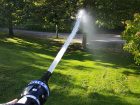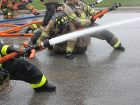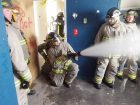
Features
Structural
Training
Back to Basics: Check the nozzle before making entry
I recently conducted a structural burn session class for a local fire department, where members had access to a school building for live-fire training. The training day allowed firefighters to refine their skills under realistic conditions.
November 9, 2017
By Mark van der Feyst
During one of our class rotations, I was the attack line instructor. Before we made entry for fire attack operations, I instructed the firefighter holding the nozzle to check the nozzle before going in. He did so by quickly opening the nozzle only a quarter of the way, so that just a trickle of water came out. Then he shut the nozzle down. As the day proceeded, I noticed some of the other teams checking their nozzles the same way before making entry. We quickly stopped the evolution so we could explain to the entire group why it is important to check the nozzle.
So why do firefighters need to check the nozzle before entering a burning structure? To answer this question fully, we need to look at two perspectives: outside the building and inside the building.
■ Outside of the Building
When we pull our hoseline off the fire truck, we will flake it out and get it ready for water to be delivered to the nozzle. After all the kinks have been removed, firefighters should ensure they have both the nozzle and a coupling for the hoseline upon entry, so there is enough hose to go in with. When water finally comes from the pump, the hose starts to fill up with both air and water. Once the hose has been filled, firefighters should let out the excess air in the handline by opening up the nozzle. If excess air isn’t released from the nozzle, the oxygen could contribute to fire growth and delay water delivery.
This can be accomplished by simply opening up the nozzle to let the air out, which inevitably lets out a bit of water as well. However, this does not mean the hoseline is ready to make entry. Crews should check the pump panel dials to make sure there is adequate water and proper pressure at the nozzle before making entry. Firefighters at the nozzle can help to ensure proper pressure by flowing the nozzle for about 15 to 20 seconds outside the building before making entry.
By taking some time to allow the water to flow, we are giving the pump operator time to ensure the pump is set properly and running without any apparent problems. Crews need to have the proper flow and pressure to combat the heat release rates (HRR) that are waiting for them inside. If you don’t have the right flow and pressure, then you aren’t armed correctly to combat HRR.
It’s also a good idea to flow water outside the structure so firefighters know they have the right stream selection with the nozzle. When using a smooth bore nozzle like in photo 1, this is not a concern, because there is only one type of stream – a solid stream. However, when using an automatic type of nozzle, there are multiple options for stream selection. In this case, firefighters must ensure they are using a straight stream.
When entering a burning structure crews should always use a straight stream. Never use a fog pattern of any type for interior attack operations; a fog pattern will be detrimental to interior operations. The fog stream can cause mass steam conversion, air entrainment and inadequate water levels for penetrating the thermal column.
An experienced firefighter should be able to tell by the sound the water makes when it hits the ground whether or not the stream is adequate. Each nozzle and hose is different, so this skill will come as you continue to practice with department equipment and flowing water.
Whenever using an adjustable gallonage nozzle, flowing the water outside will allow the firefighter at the nozzle to check they have the right selection for the amount of gallons per minute on the dial.
■ Inside the structure
So how does checking the nozzle impact the inside operations of a structure fire? Firefighters will notice the impact when they start to flow water on the fire after dragging the hoseline in. If pressure is correct and excess air has been eliminated, the fire should get smaller as crews deliver water; the fire will grow larger if this is not done correctly.
When crews are using a smooth bore nozzle, there is no concern about the pattern type changing from the nozzle moving along the floor. It will always flow a solid stream. When fire crews use an automatic nozzle, the pattern may change when the nozzle rubs against the floor, bumps into objects, and brushes against firefighters. When the nozzle comes in contact with other objects, the pattern changes. The head of the nozzle might move from the straight stream selection to a fog selection. So, when firefighters begin fire suppression efforts, they may be surprised to see a fog pattern when they open up the nozzle, instead of a solid stream as shown in photo 3.
The nozzle person needs to quickly check nozzle patterns before applying water to the fire. The firefighter can do this in one of two ways: flow a bit of water on the floor or use a free hand to turn the head of the nozzle to the right for reach. By doing this, firefighter at the nozzle knows they will have a straight stream when they begin to suppress the fire.
Mark van der Feyst has been in the fire service since 1999 and is a full-time firefighter in Ontario. Mark teaches in Canada and the United States and India. He is the lead author of Residential Fire Rescue. Mark@FireStarTraining.com
Print this page
Advertisement
- Trainer’s Corner: All firefighters should understand wildland terms
- Leadership Forum: Steps to solving personnel problems


